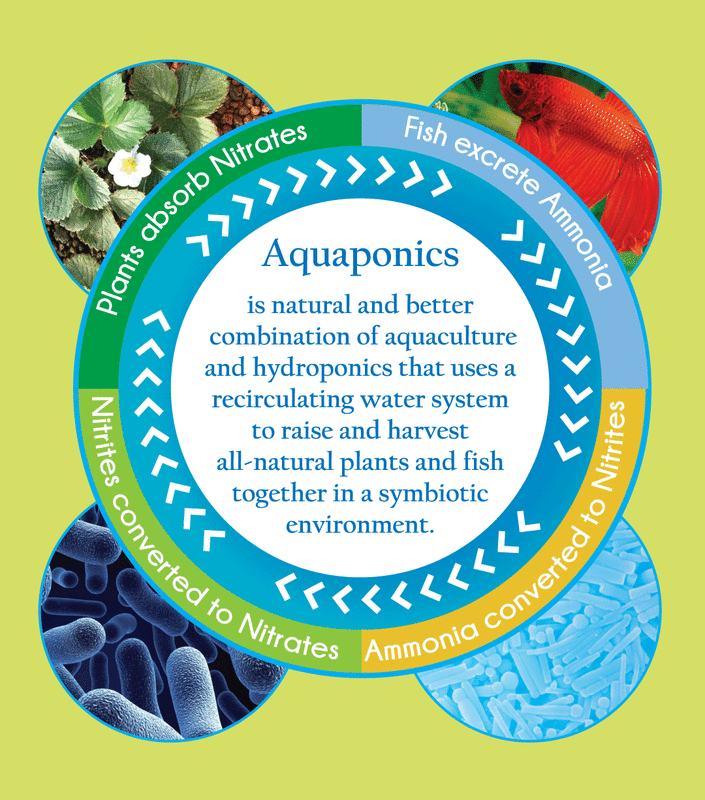
- Aquaponics is the agricultural practice of growing plants and fish in a closed, self-sustaining ecosystem… True aquaponics recycles water within a closed system which by many estimates reduced water consumption by approximately 99%. This means that a tomato grown in an aquaponic system requires 1% of the watering required by a tomato grown with traditional farming. This is because an aquaponic system is more efficient, such that the majority of the water in the system is directly used by the plants. In traditional agriculture more water is used because very little of the water goes directly to the plant. Much of the water is lost to run-off, evaporation, and soil absorption not directly being used by the plant.
- Aquaponics is a combination of both hydroponic and aquaculture methods… Like hydroponics, aquaponic agriculture grows plants without the use of soil. This is possible because soil is not a necessary component for growing plants. In traditional, soil-based agriculture the soil acts a reservoir for the nutrients required by plants to grow. In hydroponics, the plants pull nutrients directly from the water. However, there are very minimal nutrients in most water supplies. Therefore in hydroponic agriculture it if often necessary for the nutrients to be added to the water using organic or chemical solutions. This chemical-rich water cannot be re-used after it has been cycled through a hydroponic system and is actually considered toxic to humans and animals. It cannot and should not be re-introduced to the environment.
Aquaculture is a farming method used to raise fish. Often this is done in large tanks or confined pools with naturally schooling fish breeds who are naturally adapted to such an environment. However, the practice of aquaculture on its own can also result in toxic water due to high amounts of fish wastes, which must be manually cleaned and removed on a regular basis. If the waste is not removed, the water will become toxic to the fish and result in a fish kill, where all the fish die.
Both hydroponics and aquaculture on their own have challenges and require additional inputs for a single product. Hydroponics requires added chemical nutrients and has an unwanted output (toxic water). Aquaculture requires the added input of intensive labor to maintain clean water to prevent fish kills. Both only result in one product, either a plant or a protein. Aquaponic agriculture combines the best of both worlds and leave behind the unwanted parts. In an aquaponic system, fish waste in the water is cycled into grow beds where seeds or plants are growing. This fish waste water provides the essential nutrients for plant growth and reduces the need for added chemical nutrients. In turn, the plants essentially clean the waste from the water and return it back to the system where it is re-used and recycled efficiently.
- Aquaponics relies upon microbiological processes to foster the relationship between plants and fish… While the above information provides a general picture, there is actually a lot of science behind the relationship between the fish and plants thriving together. A brief explanation is as follows; however, for a more technical discussion we recommend you check out this peer-reviewed article. Ammonia is released by the fish waste, while high levels of ammonia would normally kill fish in an aquaponic system this ammonia is converted into nitrites and then into nitrates by naturally occurring bacteria that develop in the aquaponic system. Remember, not all bacteria is bad. In this case, the bacteria that occurs naturally in this system is good bacteria and necessary for a thriving aquaponic system, much like many of the bacteria humans carry on their body are good bacteria that actually keep us healthy. The nitrates that result from this conversion process are then absorbed by the plants, which provide all the necessary nutrients for the plant to grow. The result of this natural process is clean water that provides a safe environment for the fish. Check out our graphic below.

There are a couple important things to know about the aquaponic cycle…
1) The bacteria in an aquaponic system takes time to grow and develop. How long it takes is dependent on the design of your specific system, the size of the system, water cycling strategies, and fish species. There are methods to assess the required time for bacteria development in your system, and we recommend that any aquaponics farmer plan for at least one month for the system to reach its prime before planting any valuable crops or using costly fish.
2) The aquaponics cycle is on-going. For lack of a better word it is a batch at a time. It is a constant process that is naturally occurring at all times in the system. The water requires some basic monitoring to ensure that there is a healthy level. This can be done through water testing (which is recommended) and also experience. A seasoned aquaponics farmer will be able to look at his crops and know if the water requires some adjustment. However, until you reach that point and are comfortable with the inherent risks (fish kills and loss of crops) we recommend regular water testing.



